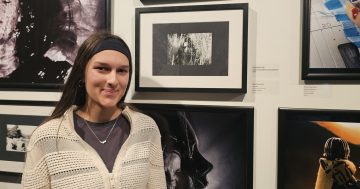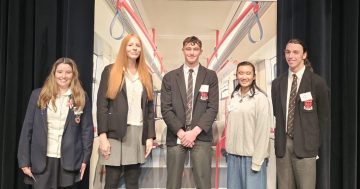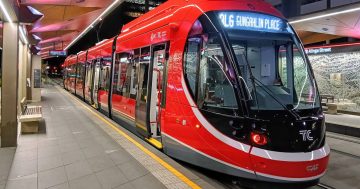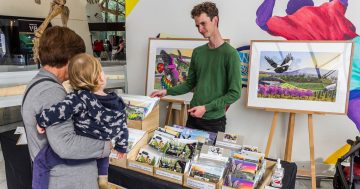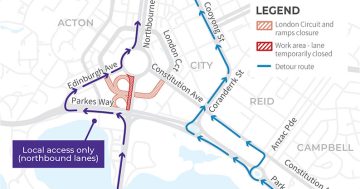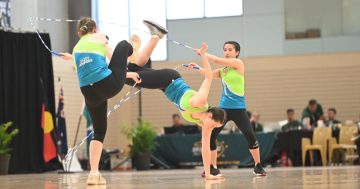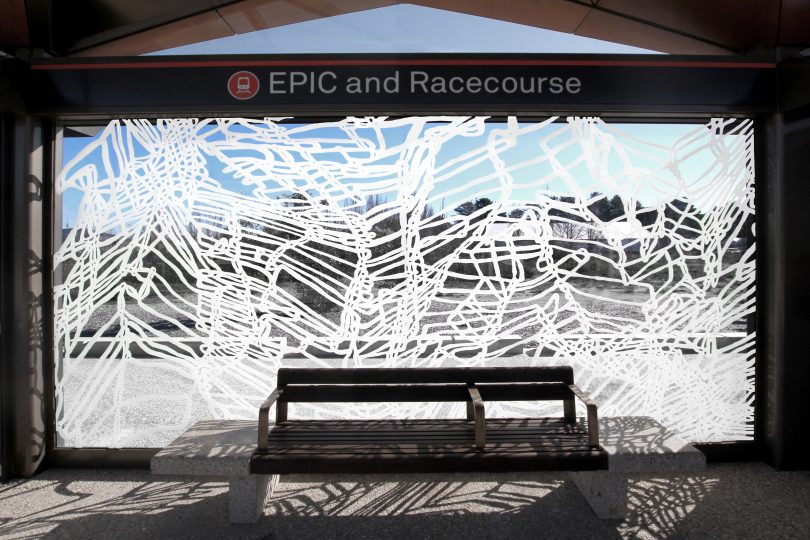
The EPIC and Racecourse light rail stop. Photo: Supplied.
Hannah Quinlivan is a local artist whose work is well known to Canberra commuters. Her drawings can be seen across the capital on the glass panels at each light rail stop between Civic and Gungahlin.
Each panel is different, and each drawing is inspired by its own location along the rail line, Ms Quinlivan explains.
To prepare the drawings, she spent a lot of time in each of the 13 locations before the light rail project was completed.
“I took photos in each location, and just spent time observing how people, traffic, green space, wind and other elements interacted,” she says.
The large abstract drawings on glass are a response to the observations that Quinlivan made in each location.
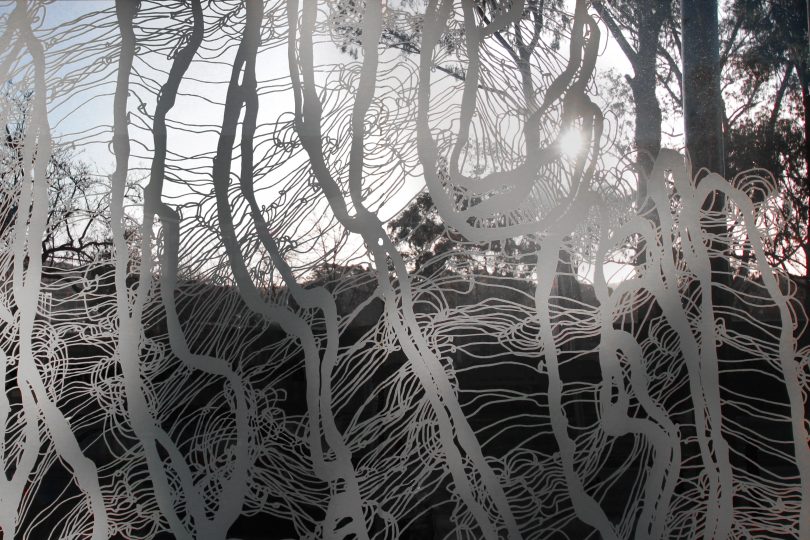
Each light rail stop is marked by an abstract drawing reflecting the local area. Photo: Supplied.
Feedback on the artworks has been positive.
“I really love that people have come to know particular drawings that are associated with the stop close to their home,” she says. One person even said “the drawings have made her look forward to her morning commute!”
The process of creating the drawings for each location gave her a deep understanding of each stop on the light rail between Gungahlin town centre and the city.
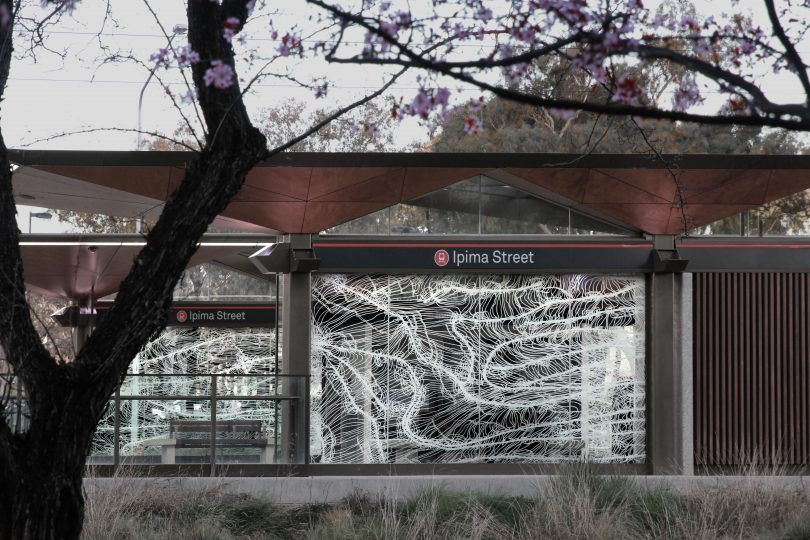
Each abstract drawing relates to close observations of the local area made by the artist. Photo: Supplied.
Canberra is Quinlivan’s home town, but she hasn’t always lived here. Like her line art, the artist has taken a circuitous journey to reach her current position as a working artist in Canberra.
She arrived in Canberra in year five and went to the Orana school in Weston.
“I’ve lived in Canberra on-and-off ever since. It’s definitely home now,” she says.
Her early years were spent in a remote Aboriginal community wich included many painters. She was later drawn back to that region.
“When I left school, I spent a few years back in Central Australia working in the arts,” she says.
“During that time, I decided that I wanted to stay involved in the arts, but it wasn’t until a family illness drew me back to Canberra that I decided to go to art school.”
Four years at the Canberra School of Art taught her technical skills and formal ways of thinking about art.
“The ANU School of Art then – and still now – has a reputation as a school with terrific workshops where you can learn lots of technical skills, as well as conceptual ones. It hasn’t yet been overwhelmed by the deskilling that has transformed other art schools,” she says.
“So I left art school being able to draw, make prints, weld, paint and so on, as well as having been immersed in learning, thinking and talking about art for four years.”
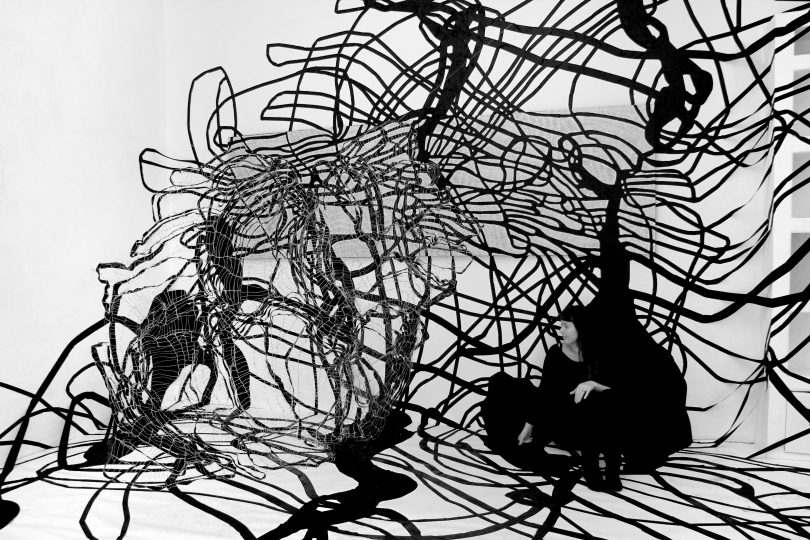
Transience, 2014 by Hannah Quinlivan installation view with the artist herself. Photo: Diana Rangel.
Building a career as an artist is hard, and after graduating, Quinlivan was realistic about her options.
“I left art school expecting to go back to my old roles in the art world, facilitating other people’s work in various ways. I didn’t expect to become a full-time artist myself,” she remembers.
But she dedicated herself to an artist’s life for a year or so to see what happened. So far, things are going pretty well.
“I’m still making art as a full-time job nearly 10 years later,” she says.
As well as the light rail drawings, this year you might have seen Hannah Quinlivan’s work hanging above David Jones as part of the annual DESIGN Canberra festival, or hovering over Lake Burley Griffin as part of Contour 556, Canberra’s sculpture biennale. In these works, drawing becomes three-dimensional, building on the exploration of space in her flat drawings.

Shroud at Contour 556, 2020, aluminium, acrylic and steel. Photo: Hannah Quinlivan.
Like many people, COVID-19 has upset Quinlivan’s travel plans, but she is finding plenty of opportunities in the local area.
“Canberra’s local art scene is incredibly supportive, and it’s a great place to be based as an artist,” she says.
Original Article published by Cass Proudfoot on The RiotACT.



